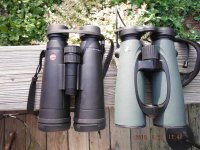I have been using electronically stabilised Canons as my primary birding binoculars for over 15 years by now, and have run out of batteries while birding maybe half-a-dozen times total. And if this happens, like Etudiant says, I'm left with unstabilized binoculars pretty much on par with any of the other alphas.
Nowadays, I re-charge my eneloops a bit more frequently and they never run out when I'm out. I cannot see any way to make a fully mechanical stabilisation system that would be anywhere near as compact, lightweight or effective as the one utilised in the Canons.
My dream binocular for the near future would be the 10x42 IS L that I have now but with fine-tuned optics and better eyecups. Or, better yet, eye-relief and eyecups taken from Swaro 10x56 or 8x56 SLC.
For fine-tuned optics, nothing more would be needed than a pair with Canon's current optics but a sample with the lowest aberrations possible with that configuration in both tubes, and in perfect alignment. My present sample is very good both by Canon standards and by comparison to any and all other alpha brands and models, but, like with any other binocular, they fall behind when compared with a truly aberration-free image such as I see daily in my ATX 95. I haven't seen it yet, but from what people I trust say (Typo, Glenn LeDrew) the Nikon WX 10x50 might be a binocular with the image quality level I'd be happy with. But, it is too big and lacks IS.
Once fully digital binoculars are capable of giving the same subjective image quality I'm getting from the Swaro ATX at 30x, to both eyes, and with stabilisation, we will have arrived at a point where I'll stop following the development of the field.
Kimmo





